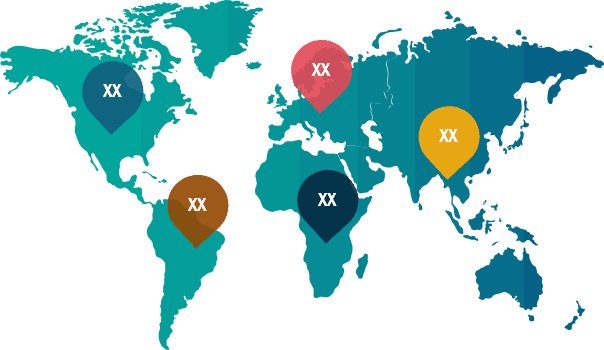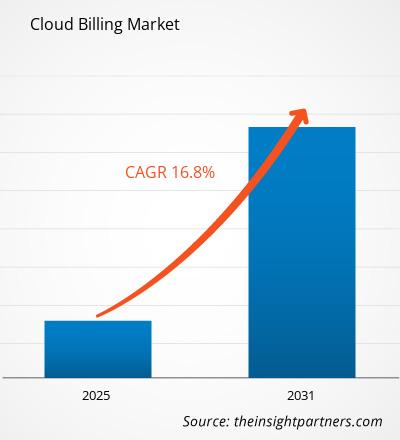クラウド課金市場は、2023~2031年の間に16.8%のCAGRを記録すると予想されています。リアルタイム課金の出現は、今後も市場の重要なトレンドであり続けると思われます。
クラウド課金市場分析
- これまで、課金システムは労働集約的で、静的なオンプレミス ソフトウェアを使用していました。対照的に、クラウド課金システムは Web サーバー上に収容され、リアルタイムのデータ処理と課金情報を提供します。
- この構成は、利用されたサービスを正確に追跡して請求するため、さまざまな消費パターンを持つサービスを提供する企業に適しています。
- クラウド請求を利用すると、請求データに関するリアルタイムの分析情報により、企業は戦略的な意思決定を行い、パターンや改善の機会を見つけることができます。
クラウド課金市場の概要
- クラウド課金は、クラウド環境のリソース消費データに基づいて請求書を生成する方法です。この課金アプローチにより、課金プロセスを自動で管理し、拡張性とカスタマイズ性を実現できます。
- これは、ソフトウェア、インフラストラクチャ、オンライン プラットフォームなどのサービスに特に役立ちます。
- これは、特にサービスと消費が顧客ごとに大きく異なる環境において、組織が請求需要を管理するための動的で適応性が高く効率的なアプローチです。
要件に合わせて調査をカスタマイズ
弊社の標準サービスでは対応できない分析と範囲を最適化し、カスタマイズすることができます。この柔軟性により、ビジネス計画と意思決定に必要な正確な情報を得ることができます。
クラウド課金市場:戦略的洞察

CAGR (2023 - 2031)16.8%- 市場規模 2023年
XX百万米ドル - 市場規模 2031年
XX百万米ドル

市場の動向
- IoT技術の採用、スケーラビリティ、自動化機能
- OPEXとCAPEXの削減の必要性
- リアルタイム課金の出現
主要人物
- オラクル
- 財務諸表
- セールスフォース
- ズオラ
- アリアシステム
- ワン8ill
- 請求プラットフォーム
- 繰り返し
- ジャムクラッカー
- セリリオン
地域概要

- 北米
- ヨーロッパ
- アジア太平洋
- 南米と中央アメリカ
- 中東およびアフリカ
市場セグメンテーション
 成分
成分- 解決
- サービス
 請求タイプ
請求タイプ- サブスクリプション
- 使用状況ベース
- 一度
 展開タイプ
展開タイプ- プライベートクラウド
- パブリッククラウド
 サービスモデル
サービスモデル- クラウド
- パース
- クラウド
- サンプル PDF では、定性的および定量的な分析により、コンテンツの構造と情報の性質が紹介されています。
クラウド課金市場の推進要因と機会
スケーラビリティと自動化機能。
- スケーラビリティはクラウド課金の重要な側面です。企業が成長したり、需要が変化したりしても、クラウド課金システムはそれに応じて調整できるため、企業は頻繁にシステムをアップグレードしたり調整したりすることなく、正確に課金できます。
- さらに、クラウド請求には、自動請求、統合支払い処理、包括的な財務レポートなどの高度な機能が組み込まれることがよくあります。これらの機能により、請求プロセスが簡素化されると同時に、収入源やクライアントの使用習慣に関する有用な洞察も得られます。
OPEXとCAPEXの削減の必要性
- クラウド請求システムは、さまざまな消費者セグメントのニーズに合わせてカスタマイズ可能な請求サイクル、価格体系、支払い選択肢を提供します。
- クラウド請求システムを使用すると、請求、支払い処理、収益認識などの一般的な操作を自動化できるため、エラーや管理上のオーバーヘッドが削減されます。
- これらのソリューションはサブスクリプション ベースであることが多いため、企業はハードウェアやソフトウェアへの多額の先行投資を回避できます。また、IT のメンテナンスやアップグレードに関連するコストも削減できます。
クラウド課金市場レポートのセグメンテーション分析
クラウド課金市場分析の導出に貢献した主要なセグメントは、コンポーネント、課金タイプ、展開タイプ、サービス モデル、企業規模、および業種です。
- コンポーネント別に見ると、市場はソリューションとサービスに分かれています。
- 課金タイプに基づいて、市場はサブスクリプション、使用量ベース、ワンタイム、その他に分類されます。
- 展開タイプに基づいて、市場はプライベートクラウドとパブリッククラウドに分けられます。
- サービスモデルに基づいて、市場は IaaS、PaaS、SaaS に分けられます。
- 企業規模別に見ると、大企業と中小企業に分かれます。
- 業界別に見ると、市場は BFSI、IT および通信、教育、ヘルスケア、メディアおよびエンターテイメント、その他に分かれています。
地域別のクラウド課金市場シェア分析
- クラウド課金市場レポートは、北米、ヨーロッパ、アジア太平洋 (APAC)、中東およびアフリカ (MEA)、南米および中米の 5 つの主要地理的地域の詳細な分析で構成されており、現在の市場規模と過去の市場規模、2021 年から 2031 年までの予測が含まれています。
- 各地域はさらにそれぞれの国に細分化されています。このレポートでは、18か国以上の分析と予測を提供し、地域レベルで市場に影響を与えている推進要因、傾向、機会などのクラウド課金市場の動向を網羅しています。
- また、レポートでは、これらの地域のクラウド課金市場に影響を与える主要な要因の調査を含む PEST 分析も取り上げています。
クラウド課金市場レポートの範囲
| レポート属性 | 詳細 |
|---|---|
| 2023年の市場規模 | XX百万米ドル |
| 2031年までの市場規模 | XX百万米ドル |
| 世界のCAGR(2023年~2031年) | 16.8% |
| 履歴データ | 2021-2022 |
| 予測期間 | 2024-2031 |
| 対象セグメント | コンポーネント別
|
| 対象地域と国 | 北米
|
| 市場リーダーと主要企業プロフィール |
|
- サンプル PDF では、定性的および定量的な分析により、コンテンツの構造と情報の性質が紹介されています。
クラウド課金市場のニュースと最近の動向
クラウド ビリング市場は、主要な企業出版物、協会データ、データベースなどの一次調査と二次調査後の定性的および定量的データを収集することによって評価されます。クラウド ビリング市場の動向のいくつかを以下に示します。
- FinOps Foundation は、比較可能なクラウド サービスのコストの比較を容易にする FinOps Open Cost and Usage Specification (FOCUS) 仕様のバージョン 1.0 を一般公開しました。FinOps X 2024 カンファレンスで発表された FOCUS は、Amazon Web Services (AWS)、Microsoft、Google、Oracle がサポートするクラウド請求書の統一フォーマットを提供します。(出典: FinOps Foundation、プレス リリース、2024 年 6 月)
クラウド課金市場レポートの対象範囲と成果物
「クラウド課金市場の規模と予測(2021〜2031年)」レポートでは、以下の分野をカバーする市場の詳細な分析を提供しています。
- クラウド課金市場の規模と予測(対象範囲に含まれるすべての主要市場セグメントについて、世界、地域、国レベルで)
- クラウド課金市場の動向、および推進要因、制約、主要な機会などの市場動向
- 詳細なPEST/ポーターの5つの力とSWOT分析
- 主要な市場動向、世界および、主要プレーヤー、規制、最近の市場動向を網羅したクラウド課金市場分析
- 市場集中、ヒートマップ分析、主要プレーヤー、クラウド課金市場の最近の動向を網羅した業界の状況と競争分析
- 詳細な企業プロフィール
- 過去2年間の分析、基準年、CAGRによる予測(7年間)
- PEST分析とSWOT分析
- 市場規模価値/数量 - 世界、地域、国
- 業界と競争環境
- Excel データセット


- Sweet Potato Market
- Aesthetic Medical Devices Market
- Clinical Trial Supplies Market
- Water Pipeline Leak Detection System Market
- Antibiotics Market
- Enzymatic DNA Synthesis Market
- Cut Flowers Market
- Procedure Trays Market
- Point of Care Diagnostics Market
- Health Economics and Outcome Research (HEOR) Services Market

Report Coverage
Revenue forecast, Company Analysis, Industry landscape, Growth factors, and Trends

Segment Covered
This text is related
to segments covered.

Regional Scope
North America, Europe, Asia Pacific, Middle East & Africa, South & Central America

Country Scope
This text is related
to country scope.
よくある質問
The global Cloud Billing market is expected to grow at a CAGR of 16.2% during the forecast period 2023 - 2031.
The adoption of IoT technology and scalability and automated features are the major factors driving the Cloud Billing market.
The emergence of real-time billing is likely to remain a key trend in the market.
The leading players operating in the Cloud Billing market are Oracle, SAP, Salesforce, Zuora, Aria System, One8ill, BillingPlatform, Recurly, Jamcracker, and Cerillion.
The report can be delivered in PDF/PPT format; we can also share an Excel dataset based on the request.
Some of the customization options available based on request are additional 3–5 company profiles and country-specific analysis of 3–5 countries of your choice. Customizations are to be requested/discussed before making final order confirmation, as our team would review the same and check the feasibility.
Trends and growth analysis reports related to Technology, Media and Telecommunications : READ MORE..
The List of Companies
1. Oracle Corporation
2. Amazon Web Services, Inc.
3. NEC Corporation
4. Computer Sciences Corporation (CSC)
5. SAP SE
6. IBM
7. Amdocs Inc.
8. Aria Systems, Inc.
9. CGI Group Inc.
10. Zuora, Inc.
The Insight Partners performs research in 4 major stages: Data Collection & Secondary Research, Primary Research, Data Analysis and Data Triangulation & Final Review.
- Data Collection and Secondary Research:
As a market research and consulting firm operating from a decade, we have published and advised several client across the globe. First step for any study will start with an assessment of currently available data and insights from existing reports. Further, historical and current market information is collected from Investor Presentations, Annual Reports, SEC Filings, etc., and other information related to company’s performance and market positioning are gathered from Paid Databases (Factiva, Hoovers, and Reuters) and various other publications available in public domain.
Several associations trade associates, technical forums, institutes, societies and organization are accessed to gain technical as well as market related insights through their publications such as research papers, blogs and press releases related to the studies are referred to get cues about the market. Further, white papers, journals, magazines, and other news articles published in last 3 years are scrutinized and analyzed to understand the current market trends.
- Primary Research:
The primarily interview analysis comprise of data obtained from industry participants interview and answers to survey questions gathered by in-house primary team.
For primary research, interviews are conducted with industry experts/CEOs/Marketing Managers/VPs/Subject Matter Experts from both demand and supply side to get a 360-degree view of the market. The primary team conducts several interviews based on the complexity of the markets to understand the various market trends and dynamics which makes research more credible and precise.
A typical research interview fulfils the following functions:
- Provides first-hand information on the market size, market trends, growth trends, competitive landscape, and outlook
- Validates and strengthens in-house secondary research findings
- Develops the analysis team’s expertise and market understanding
Primary research involves email interactions and telephone interviews for each market, category, segment, and sub-segment across geographies. The participants who typically take part in such a process include, but are not limited to:
- Industry participants: VPs, business development managers, market intelligence managers and national sales managers
- Outside experts: Valuation experts, research analysts and key opinion leaders specializing in the electronics and semiconductor industry.
Below is the breakup of our primary respondents by company, designation, and region:

Once we receive the confirmation from primary research sources or primary respondents, we finalize the base year market estimation and forecast the data as per the macroeconomic and microeconomic factors assessed during data collection.
- Data Analysis:
Once data is validated through both secondary as well as primary respondents, we finalize the market estimations by hypothesis formulation and factor analysis at regional and country level.
- Macro-Economic Factor Analysis:
We analyse macroeconomic indicators such the gross domestic product (GDP), increase in the demand for goods and services across industries, technological advancement, regional economic growth, governmental policies, the influence of COVID-19, PEST analysis, and other aspects. This analysis aids in setting benchmarks for various nations/regions and approximating market splits. Additionally, the general trend of the aforementioned components aid in determining the market's development possibilities.
- Country Level Data:
Various factors that are especially aligned to the country are taken into account to determine the market size for a certain area and country, including the presence of vendors, such as headquarters and offices, the country's GDP, demand patterns, and industry growth. To comprehend the market dynamics for the nation, a number of growth variables, inhibitors, application areas, and current market trends are researched. The aforementioned elements aid in determining the country's overall market's growth potential.
- Company Profile:
The “Table of Contents” is formulated by listing and analyzing more than 25 - 30 companies operating in the market ecosystem across geographies. However, we profile only 10 companies as a standard practice in our syndicate reports. These 10 companies comprise leading, emerging, and regional players. Nonetheless, our analysis is not restricted to the 10 listed companies, we also analyze other companies present in the market to develop a holistic view and understand the prevailing trends. The “Company Profiles” section in the report covers key facts, business description, products & services, financial information, SWOT analysis, and key developments. The financial information presented is extracted from the annual reports and official documents of the publicly listed companies. Upon collecting the information for the sections of respective companies, we verify them via various primary sources and then compile the data in respective company profiles. The company level information helps us in deriving the base number as well as in forecasting the market size.
- Developing Base Number:
Aggregation of sales statistics (2020-2022) and macro-economic factor, and other secondary and primary research insights are utilized to arrive at base number and related market shares for 2022. The data gaps are identified in this step and relevant market data is analyzed, collected from paid primary interviews or databases. On finalizing the base year market size, forecasts are developed on the basis of macro-economic, industry and market growth factors and company level analysis.
- Data Triangulation and Final Review:
The market findings and base year market size calculations are validated from supply as well as demand side. Demand side validations are based on macro-economic factor analysis and benchmarks for respective regions and countries. In case of supply side validations, revenues of major companies are estimated (in case not available) based on industry benchmark, approximate number of employees, product portfolio, and primary interviews revenues are gathered. Further revenue from target product/service segment is assessed to avoid overshooting of market statistics. In case of heavy deviations between supply and demand side values, all thes steps are repeated to achieve synchronization.
We follow an iterative model, wherein we share our research findings with Subject Matter Experts (SME’s) and Key Opinion Leaders (KOLs) until consensus view of the market is not formulated – this model negates any drastic deviation in the opinions of experts. Only validated and universally acceptable research findings are quoted in our reports.
We have important check points that we use to validate our research findings – which we call – data triangulation, where we validate the information, we generate from secondary sources with primary interviews and then we re-validate with our internal data bases and Subject matter experts. This comprehensive model enables us to deliver high quality, reliable data in shortest possible time.

 このレポートの無料サンプルを入手する
このレポートの無料サンプルを入手する